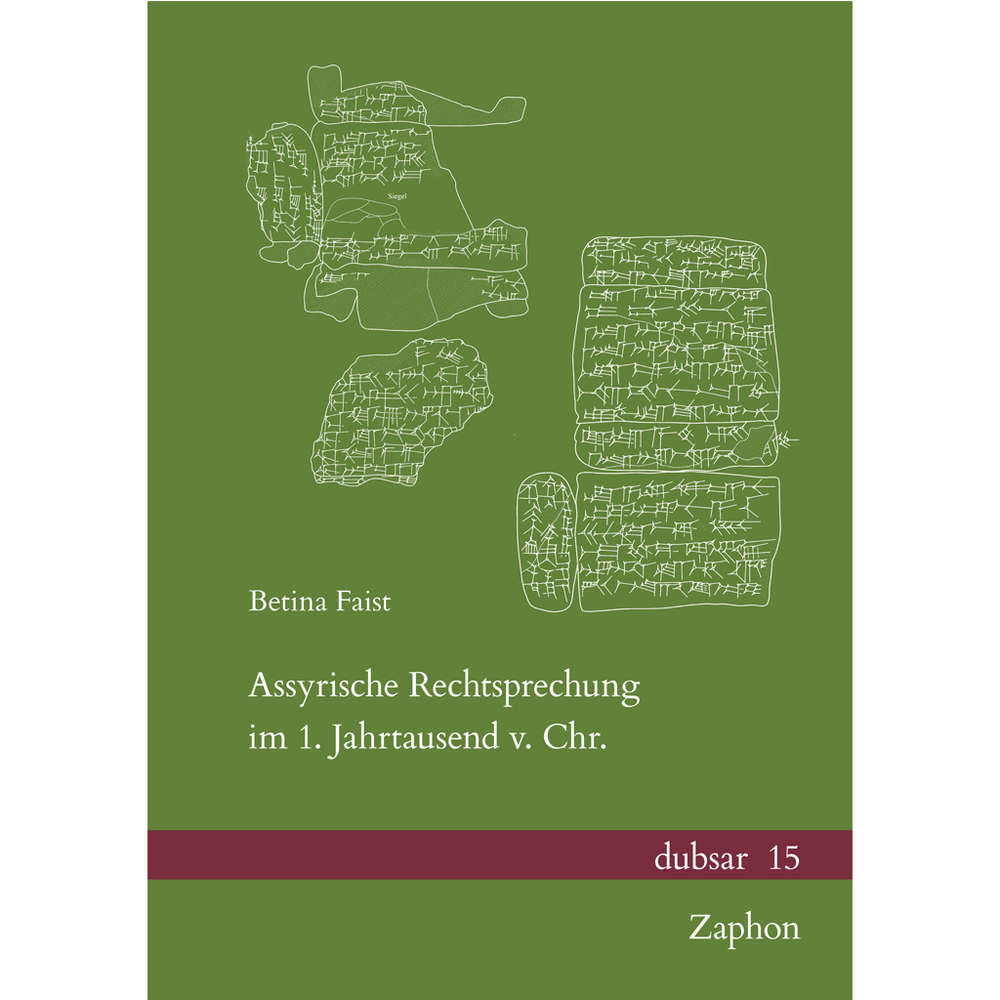Zaphon has published a book on
jurisprudence in the Neo-Assyrian period.
ABOUT THE BOOK
Betina Faist offers a systematic
presentation of the jurisprudence in the Neo-Assyrian period based on a
detailed examination of the traditional cuneiform texts. The methodological
starting point is the analysis of the linguistic design of the texts, the
research of the relevant terms and expressions as well as the critical
examination of the available sources with regard to their thematic
significance. This philological-historical approach is supplemented by a
comparison with other epochs of the cuneiform tradition and with other legal
circles. The sources available come from the “living” law of the Assyrians.
First and foremost, these are documents in Neo-Assyrian language and script
that were written down in the context of the settlement and settlement of
private legal disputes. These are characterized by their formal diversity,
which sets them apart from the other major types of documents such as A
distinction is made between sales contracts and debt certificates, which follow
a uniform form. The jurisprudence documented in the procedural documents mainly
concerns disputes under private law (“civil jurisdiction”). Legal disputes
affecting public interests, d. H. relating to the king, the palace (as an
institution) or the temples are not recorded, but are discussed in royal
correspondence. From this finding a more or less conscious distinction between
individual and collective interests, between injustice against a fellow human
being and injustice against the “state”, between “private” and “public” law can
be derived. In contrast, no distinction is made between private and criminal
law.
An appendix offers editions of 14
exemplary texts. Extensive lists of the documents examined complete the study.
TABLE OF CONTENTS
Abkürzungen / Allgemeine Abkürzungen / Bibliographische Abkürzungen
1. Einleitung
1.1 Auswahl des Themas
1.2 Ziel und Methode
1.3 Aufbau der Arbeit
2. Das Quellenmaterial
2.1 Der Textbestand
2.2 Die Typologie der Prozessurkunden
2.2.1 Die Prozessurkunden nach
ihrem Formular
2.2.2 Die Prozessurkunden nach
ihrer Funktion
2.2.3 Die Prozessurkunden nach
ihrem Erscheinungsbild
2.2.4 Die Prozessurkunden nach
der assyrischen Terminologie
3. Das Urkundenschema
4. Die Parteien und ihre Konflikte
4.1 Der soziale Hintergrund der Parteien
4.2 Die Prozessfähigkeit von Frauen, Sklaven und Fremden
4.3 Die Streitgegenstände
4.4 Außergerichtliche Einigungen
5. Die Gerichtsorganisation
5.1 Die Richter
5.2 Die Rolle des Königs
5.3 Götter als Richter
5.4 Hilfspersonal
5.5 Ort und Zeit des Gerichts
6. Der Verfahrensablauf
6.1 Die Prozesseinleitung
6.2 Das Erkenntnisverfahren
6.2.1 Die Aussagen der Parteien
6.2.2 Die Beweismittel
6.2.2.1
Zeugenbeweis
6.2.2.2
Urkundenbeweis
6.2.2.3
Eid
6.2.2.4
Gottesurteil (Ordal)
6.2.2.5
Auf frischer Tat ertappt
6.2.2.6
Anscheinsbeweis
6.2.2.7
Geständnis
6.3 Die Streitbeilegung
7. Die Rechtsfolgen
7.1 Charakterisierung
7.2 Vollstreckung
7.3 Anfechtung
8. Abschließende Betrachtungen
8.1 Zusammenfassung
8.2 Prozessgrundsätze
8.3 Formen der Gerichtsbarkeit
Anhang 1: Prozessurkunden aus Assur
Text 1: VAT 20374
Text
2: VAT 9745
Text 3: VAT 19169
Text 4: VAT 20387
Text 5: VAT 19493
Text 6: VAT 20369
Text 7: VAT 9312
Text 8: VAT 9370
Text 9: VAT 15579
Text 10: VAT 19510
Text 11: VAT 20398
Text 12: VAT 20691
Text 13: VAT 20792
Text 14: VAT 20798
Anhang 2: Die Typologie der Prozessurkunden
Anhang 3: Die Gerichtsorganisation
Anhang 4: Die Datierung der Prozessurkunden
Konkordanzen
Konkordanz der Prozessurkunden in diesem Band
Konkordanz der Prozessurkunden in Jas 1996
Literatur
Indizes
More info here


No comments:
Post a Comment
Note: Only a member of this blog may post a comment.